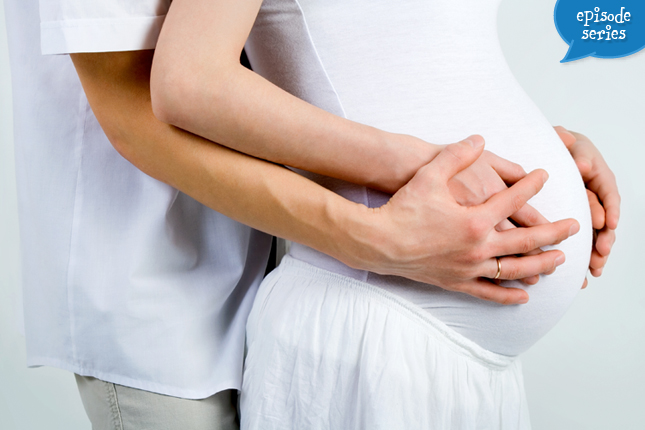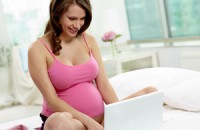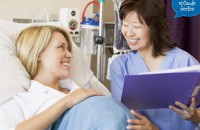Preggie Pals
Childbirth Choices : Planned Homebirths
Please be advised, this transcription was performed from a company independent of New Mommy Media, LLC. As such, translation was required which may alter the accuracy of the transcription.
[00 :00 :00]
Theme Music
Marla Hicks : More women are exploring the idea of a planned homebirth, with licensed midwife or nurse-midwives for low risk, healthy, normal pregnancies. But is it really safe? What are some of the pro’s and con’s of giving birth at home and how do you properly prepare for one? I’m Marla Hicks, a registered nurse, licensed midwife and an executive director at the Nizhoni School of Midwifery, here in San Diego. This is Preggie Pals, episode 62.
[Theme Music / Intro]
Sunny Gault : Welcome to Preggie Pals, broadcasting from the Birth Educational Centre of San Diego. Preggie Pals is your weekly on-line on the go support group for expecting parents and those hoping to become pregnant. I’m your host, Sunny Gault, have you joined our Preggie Pals club? Our members get all of our archived episodes, bonus content after each new show, plus special giveaways and discounts, and you will also get a free subscription to Pregnancy Magazine, big bonus there. See our website, Preggiepals.com for more information. And thanks to everyone who is listening to this episode through our awesome PreggiePals app. You can download it through Apple, or the Android marketplace. This is the best way, in my personal opinion, to listen to the show on the go, like when you’re out pushing your stroller, or if you’re waiting for your next prenatal appointment. And it’s absolutely free, which is even better, considering we all have babies on the way and we need to save our money. So download our app today. Ok, so let’s meet our panelist here in the studio, Will Stark, because we to have a panelist joining us on the phone. But first, let’s start with Annie.
Annie Laird : My name is Annie, I’m 35, I’m a government contractor, I am due with my third baby in October, not sure the baby’s gender, we’ll find out then and I’m planning a homebirth with our expert panelist today.
Sunny Gault : Now you’ll love how that works out.
Annie Laird : Yes.
Sunny Gault : Great birth community here in San Diego. OK, Kristy.
Kristy Iris : I’m Kristy, I’m a very young 41 and I’m an artist and designer. I’m due labor day with my first baby girl. Well, it’s a girl and it’s my first baby, and we’re planning a birth centre birth, but I’m hoping the next one will be a homebirth.
Sunny Gault : OK, all right, and Lisa.
Lisa Howe : Hi, I am Lisa, I am 37 and I have a daughter who just turned 1. She was born at home, on June 10th, last year.
Sunny Gault : Congratulations. Joining us on the phone is Laurie. Laurie has been on our sister show, Parent Savior show quite a bit. Laurie, tell us a little bit about yourself.
Laurie Babb : I’m Laurie Baab and I’m a small business owner and educator in San Diego. I’m 42 and I have two children, a two and a half year boy and a five year old boy. First one was born in the hospital and the second one was born at home.
Sunny Gault : All right, and you guys know me, I’m Sunny. I am the host and one of the producers of Preggie Pals. I am pregnant and last week we found out that we are having two babies instead of one. I am pregnant with identical twins, surprise, surprise, but that’s going to be a lot of fun. I already have two little boys. We are going to be a full house, I’m going to have four under four. We don’t know the babies’ gender yet, but since they’re identical they’re going to be the same, we hope to find out the next couple of weeks. I knew this one was going to be a cesarean, regardless, I had some complications with my first vaginal birth, and so it’s the best option for me to go cesarean, and with twins, you know, a lot has to happen anyway, so I’m OK with it. I want to introduce Stephanie here on the studio. So you guys know, she doesn’t have a mike in front of her, but I’ll introduce her for you guys. Stephi is our producer here, on Preggie Pals. One of the things I want to mention to you guys with the show, one of the new things we’re doing now is we want you guys to participate in the show, as we’re recording live. So there’s a couple of ways to do this. First of all, like our page on Facebook, because we’ll be posting some questions, it’s a great way to ask our experts questions, as we’re recording live. And the other thing is if you are on Twitter, please stop following us on Twitter, because each time we record an episode we’re going to have a little twitter party and Stephanie will be tweeting out some great information that Marla is going to be sharing with us about homebirths and, again, another opportunity for you to ask us questions and become a part of our show. OK, so we will be right back.
[Theme music – Featured Segment: News Headline]
[00:04:32]
Sunny Gault : OK, so we’re going to kick of today’s show by telling you guys about a news headline that caught my attention. Of course, we’d like to do these headlines that relate to pregnancy, and the title of this is “Would you let a dolphin be your midwife”. Apparently, this is something that a Hawaii based institute is pushing. It is a good thing. From this serious institute, which I find to be very ironic, because I thought this was a joke when I first read it, but this serious institute is pushing that couples get in the water with these dolphins, and it’s supposed to help make them feel better. They said here it’s all about reconnecting humans with the dolphins, so we can coexist in this world together and learn from one another. They also say children born in the water with the dolphins develop six months faster over the first six month and have 150 grams more brain weight.
Laurie Babb : Based on what sample size?
Sunny Gault : Good questions, really. It also says they’re ambidextrous. I don’t know why that really matters.
Laurie Babb : If you have a little boy and you want him to be a pro-baseball player.
Sunny Gault : Exactly.
Laurie Babb : Exactly. That’s a lot of money right there.
Sunny Gault : Go swim with some dolphins. But anyways, what do you guys think about this? Obviously it’s not that the midwives are catching the baby and doing all the stuff that midwives are doing. So the title is a little misleading, but it’s about bonding with these creatures and developing this relationship to helping your birth.
Laurie Babb : Sunny, I mean we’re here in San Diego, so I think everybody thinks that these creatures are just very friendly. When I was in the navy, it was awesome to go on the bridge of the ship and see the dolphins, they love playing with the bow wave and that was just very neat to watch. But in my last job in the navy I dealt with I was actually in the water with the dolphins, there were exercises they were developing. We’re dealing with dolphins finding sea mines. These are wild animals. In the previous job I dealt with dolphins that were force protection assets, they would attack swimmers in the water. Even when they’re trained, these are huge 600 pound animals, they’re dangerous. I certainly wouldn’t do it and I worked with dolphins. Maybe that’s why I wouldn’t do it, because I just know they’re not these smiley things that squeak at Sea World.
Sunny Gault : Look at this picture and the dolphin always looks like he’s smiling and why wouldn’t want to give birth next to this thing? But that’s not always the case, is it anyway? Marla, I know you had some experience with this, but you have been asked to do something like this before?
Marla Hicks : I was asked to do an ocean birth with dolphins, but I had to turn it down. There were a number of reasons I had concern about dolphins as mammals in the wild, I also had other concerns that had to do with other kinds of animals that are attracted to human blood. This is not a bloodless birth, we can’t encapsulate your placenta very well either, taking in to shore, in tow with the baby. How are we swimming back? It really was not a situation that I wanted to put any pregnant woman, or even myself, in. So I respectfully declined, I don’t know what happened to the prospective client…
Sunny Gault : So you didn’t pursue a joint venture with Sea World?
Marla Hicks : They should have a special package “Give birth with our dolphins”
[Theme Song]
[00:08:18]
Sunny Gault : Women all across the world have been giving birth in their homes since the beginning of time, but the concept is still concerning to many people here in the United States. So what exactly happens during a home birth? Is it considered a safe way to birth your baby? This is the first episode in the new series, here, on Preggie Pals, exploring your childbirth choices. And joining us here in the studio are Mara Hicks, registered nurse, licensed midwife and executive director at the Nizhoni School of Midwifery here, in San Diego. Hi Marla, welcome to Preggie Pals.
Marla Hicks : Thank you.
Sunny Gault : So what is the definition of a planned homebirth, I want to make that distinction because a while back, in an episode on…
Marla Hicks : Unassisted child birth.
Sunny Gault : Unassisted childbirth, yes, so when we’re planning a homebirth, what typically happens?
Marla Hicks : Well most women who are considering a homebirth know fairly early on in their pregnancy that they are considering it. So when we are talking about what kind of care is given, we, as license midwifes an the same would be said about certified nurse midwives, are licensed to provide care throughout the prenatal period, and also intrapartum, during labor and birth, and the immediate postpartum, then the follow-up post-partum care, and the newborn care. Licensed midwives are license to provide that newborn care for the first six weeks of life. So when you’re planning a homebirth, you’re not just planning to have this sort of willy-nilly kind of experience. It’s an intentional experience. Most women, husbands and partners who choose homebirth go into it with quite a bit of good information, they are well-researched, they are concerned and caring about their child safety. They are also concerned about their own, personal experience of birth, and feel that that’s important and that that’s not making them selfish or narcissistic to be concerned about what kind of experience their family is having in welcoming this new baby. So we see the women prenatally, then we attend them for their labor and birth, and then we see them postpartum, and of course we see their newborn too. We give full service care in that respect. Provided that everything is going well, and there’s no risk, we can continue with the plans of having a baby at home.
Annie Laird : Yes, I have a question for Marla. Is there a difference in the prenatal care that a mother would get between working with a midwife for a homebirth, versus working with an OB?
Marla Hicks : Thank you for the question. Generally, one of the major differences is that, as license midwives, we have an opportunity to spend more time with the patient. I think that there are a lot of obstetricians who wish that they could have more time with patients. However, as licensed midwives or certified nurse midwives, we have the opportunity to spend usually an hour for prenatal visit, and we get a lot done during the hour, it’s not just chit-chat. The environment surrounding the prenatal visit is important, it’s important that we have the opportunity to find out from the mom how are you really doing, how are things going in your home; are you eating well; do you have stresses; do you have concerns; how are your sleeping habits; how’s your energy level, all of these things. And that gives a complete picture as to what’s going on, which makes a difference in terms of outcomes. And unfortunately, the way that our health-care system is setup, even if an obstetrician wanted to spend that amount of time here, he or she would be hard pressed to do so.
Sunny Glaut : One of the big questions that I think a lot of people have when considering a homebirth is “oh my gosh, is that safe?” As I said in the beginning of this episode, women do this around the country because this is how it’s done, but I think that there is still a little bit of a stigma here that you’re doing something that’s kind of French here. Wow, you’re a rest-taker, you’re doing birth at home. So, what would you say to that, Marla?
Laurie Babb : I hear all the time “Wow, you’re so brave”
Marla Hicks : Yes, I actually feel that way, because I am afraid.
Sunny Glaut : Anyway, what do you say to people, Marla, about the safety issue that people have?
Marla Hicks : I actually attend homebirths because I am not a risk-taker and I do feel that it is safer. I work labor and delivery, postpartum, the nursery, so I’ve had a good amount of experience within the hospital setting and I’ve also worked in free-standing center. My experience is that homebirth is very-very safe under the right circumstances, if you have one baby, and its head down, and the mother is in vibrant good health, and she has a good medical and obstetrical history, then she is probably a very good candidate for a homebirth. I think that people misunderstand what happens at a homebirth, they think perhaps that we don’t monitor the baby’s heart rate, or we just show up the at minute to catch and you are on your own before that. There are a lot of misconceptions about what happens at a homebirth. But we do anything we can to create a safe environment. Our job is to watch for complications and to either set those right, or to make the call that says “We need to go to the hospital at this point and time, because we’re trending in the wrong direction.
Sunny Gault : We have a question from one of our Facebook friends. Kelly Robbie wants to know “Is it safe for women over 35?” She says that she had two natural intervention free births before. Does that help, the fact that you’ve been through an actual labor before? Does any of that help in having a successful homebirth?
Kelly Robbie : See, Kelly is my fake name, because I am 35 and I have two children, and now I’m pregnant with my third, so that’s a fair question “Does advanced maternal age play a factor in homebirth?”
Marla Hicks : It doesn’t have to play a factor in homebirth. Part of the difficulty in answering this question is that we individualize our care very precisely for each person involved. But there are times when being 35 or older can make a difference. There are other times when it doesn’t seem to create any difficulty at all, and many times we can expect that things will go quite normally, particularly if someone has had children before. So I think that it isn’t a huge factor in and of itself. You have to look at the whole picture.
Lisa Howe : That was actually one of the things that were really reassuring to me, because I was over 35, I was almost 37 when I had my daughter. When I was interviewing midwives, I did see an OB for an initial visit and the whole office, the nurse was concerned of my age. And with all the testing they needed to do because of my age, as if my body had some sort of alarm clock that went of at 35 and said “Oh, you can’t do this now”, or “There’s going to be problems”. It was never an issue with my midwives. I was just... I was just Lisa.
Sunny Gault : And note to our listeners, we just did an episode on advanced maternal age, so if you guys want to know more information about that, and what that entails, and what typically happens, be sure to check that episode. We’re going to take a quick break, so we’ll be right back.
[Theme song]
[00:15:57]
Sunny Gault : Welcome back. Today we’re learning all about homebirths, and our special expert is Marla Hicks. Marla is a registered nurse and a licensed midwife. So Marla why would you think that women choose to have homebirths?
Marla Hicks : From my point of view, most women choose to have homebirths because they are concerned with bringing their baby in to a situation that is they want to have a physiologic labor, they want to have an undisturbed labor, they want to have a birth experience that feels supported and where they can expect to have some say over procedures and that their vote counts about that and that they don’t need to anticipate having an argument. So I would say that for some people it has to do with a safety issue in the other direction then the way that most people look at it, as a safety issue. Most people think that homebirth is unsafe. From my point of view, most women who are choosing homebirth think that it is safer, and that’s why they choose a homebirth.
Sunny Gault : Really unique perspective, yes. Ladies here in the studio who have had homebirths, and also Laurie will get to you on the phone as well. What is your reasoning for wanting to pursue this, is it the same stuff that Marla is talking about, or did you have some different reasons?
Annie Laird : My first birth in the hospital was fine. I didn’t realize, I think, what I was missing with midwifery prenatally. And again it wasn’t my obstetrician’s fault, she had to get through a certain amount of people in the office, waiting, always packed. So I didn’t get to spend a lot of time with her. But the birth was fine. Postnatal, though, in hospital there was a really rough entrance for my baby. There was a lot of concern, for her size, a lot of mess up in the hospital regarding her care. She wasn’t treated gently at all, so it was really hard time postpartum. I wanted to be in a place where the birth to be fine, but then postnatal that I would just have my baby with me and no one would be bugging her with “we need this injection, we need this test, wee nee this and we need this and we need this”
Sunny Gault : What do you think, Lisa?
Lisa Howe : I work in hospice, so part of my job is to help for some people die at home. To me, birth and death are the two most sacred times in our lives, and so it was never a question to me where I was going to have a child if I decided to become a mother. The idea of having my daughter in the privacy of my own home, where I could be left to labor however I wanted, wherever I wanted, without anyone talking to me if I didn’t want them, without the noise and the bright lights and the activity of a hospital, not to mention the germs and the concerns about the interventions. I knew that it would be the right place for me, because of the privacy, comfort and peace.
Sunny Gault : Laurie, on the phone, what was the reason that you chose homebirth?
Laurie Babb : Well, I could probably talk the whole show about it. My first was going to be a natural birth that I had was going to have with midwife support in the hospital. But it turned out to be so unnatural. So I was very curious with the second one, why did it turn out that way and how much do I really still need to learn about birthing. It’s my business and really amazing thing that I knew nothing about. So I really did some research. There was that other guest that said that birth was a very sacred time and wanting to contribute to the peace and the vibe of the birth that I could. And I felt it wasn’t really that possible in the hospital. If it was possible for me, I wanted to try the homebirth. I also knew that I wasn’t going to have any more children. I was actually 36 with the first one, and just about 39, one month shy of 39 when I had my homebirth. I was pretty healthy, but I had had complications at the first birth, so it took a while working through fear, and that was one of the biggest excuse I noticed that the prevailing emotion around my first birth was fear and I don’t want to live out of fear. I really try to work on living more out with trust, and love, to be a more positive being. So as fearful as all the energy is off when you feel about homebirth “Oh my gosh, is that safe?” Actually, with my research and my experience I realize that my hospital birth was likely far more risky for me and my child then the way the homebirth was going to be.
Sunny Gault : Arlight, Marla, what would you say some of the benefits and some of the risks are at homebirth?
Marla Hicks : As far as the benefits are concerned, they are many. I think that the ability to choose what is important to you and to be able to prioritize and feel that your choices will be respected is very important. That not whether you had candies burning or a nice music playing. These are real choices that women and their husbands and partners are making with regard to being able to birth in a variety of positions, being able to have something to eat or drink during labor, being able to allow the umbilical cord to continue to pulsate until that complete fetal maternal transfusion is done. That’s the baby’s first tensile transfusion, so that’s important, those kinds of issues and some things that were mentioned earlier, including avoidance of what we call the “cascade of interventions” in obstetrics, which can often result in unwanted outcomes, in terms a caesarian section. Sometimes, those are important and sometimes those are done unnecessarily. And so women can have quite a few benefits they can expect to accrue from having a birth at home. But really a lot of what happens that is of value happens prenatal. And so the amount of time that we were able to take with a woman, being able to counsel her, listen to her fears, being able to advise her about her nutrition. As a result of that, a kind of care are able to frequently avoid problems such as pre-term labor, abruptio placentae. There are a number of benefits that really accrue that are beyond the niceties, the comforts, the things that women enjoy but are often accused of being selfish. There’s just an array of benefits.
Sunny Gault : Marla, let’s talk about a little bit about the risk. I want to make sure that we cover everything here. So tell us a little bit more about the risk associated with the homebirths.
Marla Hicks : The risk that is involved is distance from a hospital, if you have a time pinch emergency. Those don’t happen very often, but when they do happen you need to be prepared to make a ready transport. I think that we diminish the risks quite significantly when we are careful about our risk assessment at the beginning of the pregnancy and over the course of the pregnancy. Our goal is to have a healthy woman and a healthy baby. So we start our care by ensuring that’s who’s coming into care if she needs to be nutritionally short-up and maybe taught about some new ideas about what she can do to improve her nutrition, then we do that. We’re monitoring the entire way in terms of the progress of the pregnancy, to make sure that she stays not only low risk but healthy. We want her to be vibrantly healthy by the end of the pregnancy. If someone isn’t vibrantly healthy, if they’re having issues then they need to be risked out. So you dramatically decrease the risk of homebirth by making sure that you have someone who’s very, very healthy and strong by the end of the pregnancy. However, there are things that can occur during a birth, for example you may have problems with fetal heart tones that are unexpected, particularly since we are not giving medications at home and women are allowed to eat and drink and be upright. We really don’t anticipate having problems with fetal heart rate, but we’re still checking for it. So if we find that there are problems with fetal heart tones, if we found that there’s lack of progress or that the mom is becoming exhausted because of a loner labor, then those are the things that are going to take us into the hospital. Some complications, or even emergencies, are actually, in my opinion, afforded better options at home, in the sense that you may be able to move the mother, whereas if she’s completely anesthetized with an epidural you may have difficulty with that. Shoulder dystocia is an example, I know that that’s the one “big scary”, but when we have a shoulder dystocia at home, we’re able to move the mother into a variety of positions very quickly; she is un-anesthetized. We are trained to handle these kinds of complications and that is the kind of complication that you must handle on the spot. But I think the point of all of these is to say that home based midwifery care is designed to be safe and to be attentive. If we see in our observations things that aren’t going really well, the plan is to move her into the hospital and to create a seamless a transport situation as we can, so it can be handled efficiently and so that we don’t have a bad outcome.
Sunny Gault : So, Marla, what is actually needed for homebirth?
Marla Hicks : Many people think that you have to have an array of supplies. In actuality the couple orders a box of supplies. It comes to their home. It has the disposable kinds of things that they need for a homebirth, things that are specific for them in terms of maintaining good quality control, infection control. So there are disposable under-pads, there are sterile gloves, there are little packets of gel, there are straws, there’s a variety of things that come in this box. That’s really all that the couple needs to have in addition to things like sheets and pillow cases, and an assortment of things that they would normally have around the home. We like towels in our practice, lots of towels, especially if you plan a water birth. So we have a list of things that are recommended and we ask that the couple make sure that they have those things on hand; so that’s really not difficult. As far as equipment is concerned and what midwives bring to the birth, I’m kind of obsessive about equipment : I have backups to my backups. So I just want to make sure that there’s not something there that I wished I would’ve had. So I bring in three rolling tackle boxes, essentially keep them well organized, and everything is well inventoried, and everything is ready for the birth. I’ll probably use 3% of that in any given birth, but it’s my comfort zone and I’m going to keep it that way. So I’m kind of the equipment midwife, I know that there are midwives who equip much less equipment, but I really want to have it. So things that we’re allowed to bring to a birth, as far as safety kinds of helpers, include things like IV fluids, medications that are anti-hemorrhagics, we have oxygen under the parameters and recommendations as far as oxygen at births has changed. But we do still carry it, in case we need it. There’s an assortment of instruments that we use. We are allowed to suture, although we don’t suture more than a second degree laceration and we don’t see many of those. So we have the basics that we need and I do everything that I can to keep them in the tackle boxes and if we need them, they’re there.
Sunny Gault : So ladies that have had birth is there anything that you would add to that list, or anything you would advise mother who want to have a homebirth tab on hand? Annie?
Annie Laird : Food, lot’s of food.
Sunny Gault : There you go, yes. There’s no restriction on food, right?
Annie Laird : That was glorious, because I am a labor doer, and there are a lot of hospitals that say ok if you’re to drink things. But eating…
Sunny Gault : I didn’t eat anything with my vaginal birth, I had ice chips, and that was it.
Annie Laird : It got harder as these things progressed. Eating early on, I was having a great time, eating and cooking, and then I got 17 cm and the decision was made “Ok, you’re going to the hospital”. Marla was saying “Oh, you have to eat before you go in”. I think I just thrown up or something. But being able to nourish myself.
Kristy Iris : We planned for all this food that I felt that I might want to eat, it turned out that I didn’t want anything to do with any of it. He, I remember very distinctly, handed me a cracker, I took a bite of it and told him in some colorful language that I didn’t want anything to do with it, I threw the cracker, which we found 6 weeks after my daughter was born. He said “I found this cracker with a bite taken out of it”, “That’s from my labor”. Save that for the baby. So other than those supplies, we did have a birth tab, and we had lots of towels, to protect the carpet.
Sunny Gault : What about you, Laurie? Is there anything you would recommend that new moms have on hand?
Laurie Babb : I think it’s all been said. I did have a birth thing tab, and I think women sometimes stress about that. I actually got a 25 dollars kiddy pool and it was perfect, because I actually ended up only being able to use it for maybe half hour. So I just want to throw that in, because I know that sometimes something that people labor on and they might not even actually use it. I am actually still using the kiddy prep towel. Yes.
Sunny Gault : The kids are still enjoying that. I know we can talk about this for hours and hours, there’s so much to go on with the homebirths. We just scratched the surface, but we are running out of time, so thank you ladies for being a part of our conversation, Marla for being here today. If you want more information about our experts and our panelist, please visit the episode page on our website. This conversation continues for the members of our Preggie Pals Club. After the show Marla will give us her list of the top questions you should ask midwives before you hire them for your homebirth. To learn more about our club, you can visit Preggiepals.com.
[Theme Music] [Featured Segment: The Best Online Pregnancy Resources]
[00:31:36]
Sunny Gault : Before we wrap today’s show, here’s Jeanette McCulloch with some of the best online pregnancy resources.
Jeanette McCulloch : Hello, Preggie Pals, I’m Jeannette McCulloch of BirthSwell. We at BirthSwell believe that you, the mother, will make the right help decisions for your pregnancy and birth when you have access at evidence based information and strong support system. That’s why I’ here to share with you new media tools to timed information that’s right for you. You may have heard of Ina May Gaskin. She’s the legendary midwife who found the department Midwifery Centre in Tennessee in 1970. She’ll tell you just how important it is to hear birth stories, all kinds of birth stories, while you’re pregnant. If you’re showing, you’ve probably already heard more than one unrealistic birth story. If it was well meaning, but felt a little more like a war story than a love story, you are not alone. There’s something about our birth culture that makes the sharing of positive stories taboo. But as she would say “While stories can’t tell you what your own experience would be like, they can illustrate how wide the range of normal births is”. That’s why birthstoriesondemand.com is such a great resource for preparing for birth. Click on the “read birth story” and you’ll find anything from natural birth stories to homebirths, to quick births. While there’s plenty of positive options to explore, including sections on midwife assisted birth, the site doesn’t shy away from the kinds of stories that help us know the full range of experiences, including pre-natal birth disorders. You can also listen to her podcast, watch her new birth stories on Tweeter and, of course, share your own birth story if you like. You can find the site at birthstoriesondemand.com. Thanks for listening to today’s tools for finding the information that’s right for you and be sure to listen to Preggie Pals for more great pregnancy tests in the future.
[Theme Music]
[00:33:42]
Sunny Gault : That wraps up our show for today. We appreciate you’re listening to Preggie Pals. Don’t forget to check out our sister show Parent Savior, for parents with newborns, infants and toddlers. And our show The Boob Group for moms who breast feed their babies. Next week we’re talking about pregnancy food cravings. What do they really mean. This is Preggie Pals, your pregnancy, your way.
[Disclaimer]
This has been a New Mommy Media production. Information and material contained in this episode are presented for educational purposes only. Statements and opinions expressed in this episode are not necessarily those of New Mommy Media and should not be considered facts. Though information in which areas are related to be accurate, it is not intended to replace or substitute for professional, Medical or advisor care and should not be used for diagnosing or treating health care problem or disease or prescribing any medications. If you have questions or concerns regarding your physical or mental health or the health of your baby, please seek assistance from a qualified health care provider.
[00:34:48]
[End Of Audio]












